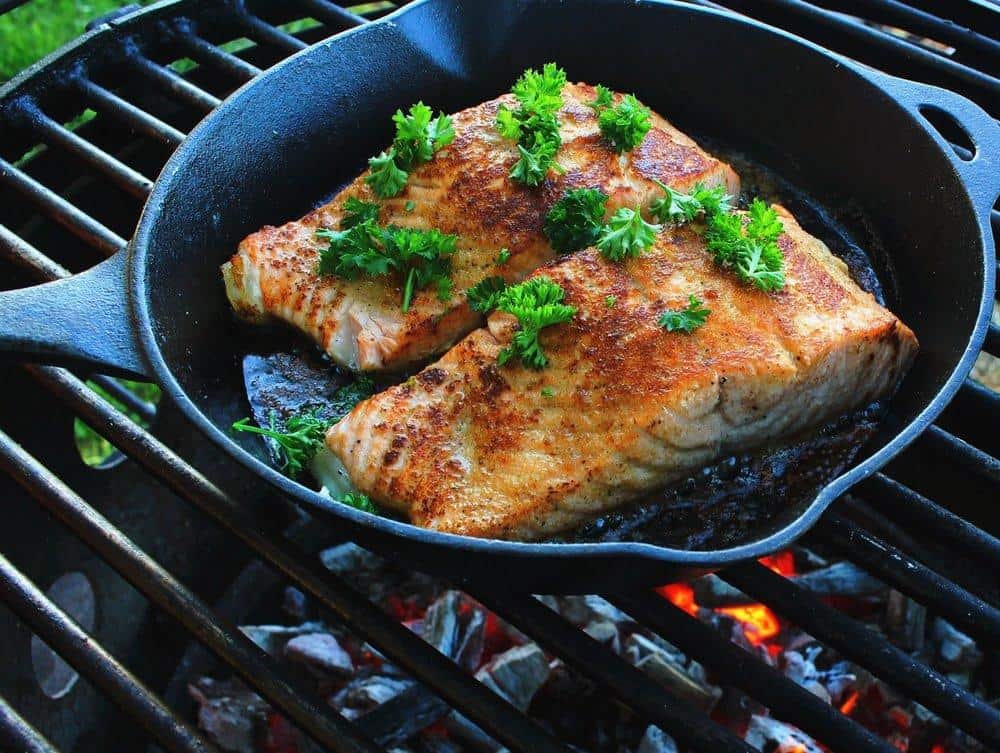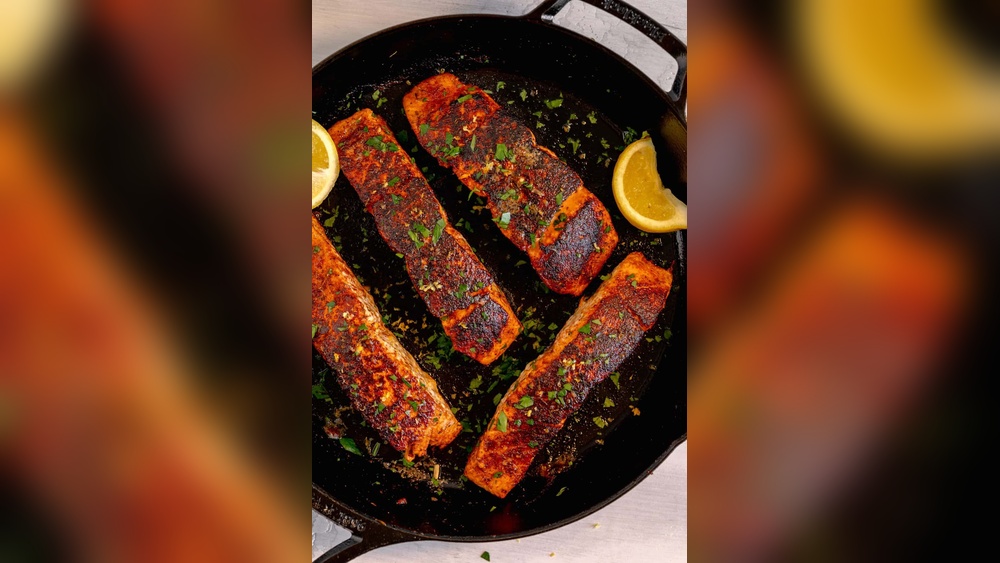Are you wondering if you can cook salmon in a cast iron skillet? The answer might surprise you.
Using a cast iron skillet can give your salmon a crispy, golden crust while keeping the inside tender and juicy. But there are some simple tricks you need to know to get it just right. If you want your salmon to taste restaurant-quality without complicated steps, keep reading.
You’ll discover how this kitchen tool can transform your cooking and make your next meal unforgettable.

Credit: overthefirecooking.com
Choosing The Right Salmon
Choosing the right salmon matters a lot for cooking in a cast iron skillet. The type and quality of salmon affect taste and texture. Picking the best salmon helps you get a delicious meal every time.
Consider freshness, cut, and whether the skin is on or off. These points guide your choice for perfect cooking results.
Fresh Vs Frozen
Fresh salmon offers a clean, bright flavor. It cooks quickly and stays tender. Frozen salmon is easy to store and lasts longer. Thaw it slowly to keep the texture firm. Both work well in a cast iron skillet. Fresh is best for flavor; frozen is best for convenience.
Skin-on Or Skinless
Salmon with skin cooks evenly and holds its shape. The skin crisps up nicely in a hot skillet. Skinless salmon cooks faster but can break apart. Skin adds flavor and protects the flesh. Choose skin-on for a crispy bite and skinless for quick, easy cooking.
Preparing Your Cast Iron Skillet
Cooking salmon in a cast iron skillet gives a tasty, crispy finish. Preparation of your skillet is key to perfect results. The right steps protect the pan and keep the fish from sticking.
Before cooking, make sure your skillet is clean and well cared for. This helps the salmon cook evenly and makes cleaning easier after. Here are two important steps to prepare your skillet.
Seasoning The Skillet
Seasoning your cast iron skillet creates a natural, non-stick surface. Use a small amount of oil like vegetable or flaxseed oil. Rub it over the entire pan, inside and out.
Place the oiled skillet upside down in an oven at 375°F (190°C) for one hour. Let it cool inside the oven before using. This process builds layers of protection for cooking salmon.
Preheating Tips
Preheat your skillet before adding salmon to get a nice sear. Heat it on medium for about 5 minutes. Test by sprinkling a drop of water—if it sizzles, it’s ready.
Do not overheat. Too hot can burn the salmon and damage the skillet’s seasoning. A properly heated pan cooks salmon evenly and seals in moisture for better flavor.
Salmon Preparation Techniques
Preparing salmon properly helps you get the best taste and texture. Simple steps make a big difference before cooking in a cast iron skillet. Focus on drying the fish and adding the right seasonings.
These techniques ensure the salmon cooks evenly and develops a nice crust. They also bring out the natural flavors of the fish. Let’s explore these important preparation steps.
Patting Dry
Use a paper towel to gently pat the salmon dry. Removing moisture helps the fish brown better in the skillet. Wet salmon can steam instead of sear, making it less crispy.
Make sure to dry both sides well. This step also prevents oil from splattering during cooking. A dry surface means a crispier and tastier result.
Seasoning Options
Salt and pepper are the simplest way to season salmon. Sprinkle evenly on both sides for balanced flavor. You can also add garlic powder, paprika, or lemon zest for variety.
Herbs like dill, thyme, or parsley pair nicely with salmon. Use fresh or dried herbs according to your taste. Light seasoning lets the fish’s natural flavor shine.
Cooking Salmon In Cast Iron
Cooking salmon in a cast iron skillet is a popular and effective method. This technique helps create a crispy skin while keeping the fish moist inside. The skillet holds heat well, giving the salmon a beautiful sear. It also cooks evenly, making it easier to get perfect results every time.
The key is to control the heat and cooking time carefully. With the right steps, you get a delicious, restaurant-style salmon at home.
Optimal Heat Settings
Start by heating the cast iron skillet on medium heat. Avoid high heat to prevent burning the salmon skin. Medium heat allows the fish to cook gently and evenly. Preheat the pan for about 3 to 5 minutes. Add a small amount of oil with a high smoke point like canola or vegetable oil. This helps the skin crisp up nicely without sticking.
Cooking Time For Crispy Skin
Place the salmon skin-side down in the hot skillet. Cook for about 4 to 5 minutes without moving it. This time lets the skin become crispy and golden brown. The salmon will cook most of the way on this side. Avoid pressing down on the fish to keep the juices inside. Adjust the time slightly if your fillets are thicker or thinner.
Flipping The Salmon
Use a thin, flexible spatula to flip the salmon gently. Flip only once to keep the fish intact. Cook the other side for 2 to 3 minutes to finish cooking. The flesh should be opaque and flake easily with a fork. Remove the salmon from the skillet and let it rest for a minute. This step helps the juices settle and improves flavor.
Achieving Perfect Crispiness
Achieving perfect crispiness on salmon cooked in a cast iron skillet makes every bite delicious. The secret lies in careful cooking techniques. Crisp skin adds a lovely texture. It also helps lock in moisture inside the fish. A few simple steps create that ideal crispy crust.
Using the right fat and handling the fish properly are key. The skillet must be hot but not smoking. This balance helps the skin brown evenly without burning. Patience and attention during cooking bring the best results.
Using Oil And Butter
Choose oils with a high smoke point like canola or avocado oil. These oils resist burning at high heat. Add a small amount of butter for flavor near the end of cooking. Butter browns quickly and adds richness. Pouring butter over the salmon while cooking helps crisp the skin.
Heat the oil first until shimmering. Then place the salmon skin-side down. This method creates a nice sear. Keep the oil just enough to coat the pan. Too much makes the salmon soggy instead of crispy.
Avoiding Sticking
Dry the salmon skin thoroughly before cooking. Moisture causes sticking and prevents crispiness. Use a paper towel to pat the skin dry. Preheat the cast iron skillet well. A hot pan helps release the skin easily.
Do not move the salmon too soon after placing it in the pan. Let it cook undisturbed until the skin lifts naturally. If the fish resists, wait a little longer. This patience prevents tearing the skin and keeps it intact.

Credit: tasty-yummies.com
Serving Suggestions
Serving salmon cooked in a cast iron skillet is a delight. The rich flavor pairs well with many sides and sauces. These additions make your meal more enjoyable and balanced.
Complementary Sides
Roasted vegetables like asparagus or Brussels sprouts match well with salmon. Light salads with fresh greens add a refreshing touch. Mashed potatoes or rice provide a comforting base. Steamed broccoli or green beans offer a crisp texture contrast. These sides keep the meal colorful and healthy.
Sauces And Garnishes
Lemon butter sauce enhances the salmon’s natural taste. A simple dill yogurt sauce adds creaminess without overpowering. Fresh herbs like parsley or chives bring a burst of color and flavor. A sprinkle of capers gives a salty, tangy bite. These toppings brighten the dish and make it more exciting.
Cleaning And Maintaining Cast Iron
Cleaning and maintaining cast iron is key to keeping your skillet in great shape. Proper care keeps the surface smooth and non-stick. It also stops rust from forming. Each step after cooking helps protect your pan for many meals to come.
Post-cooking Care
After cooking salmon, let the skillet cool slightly. Use hot water and a soft brush to clean it. Avoid soap, as it can strip the seasoning. For stuck bits, scrub with coarse salt and a little water. Rinse well and dry completely with a towel. Heat the pan briefly to remove any leftover moisture.
Long-term Maintenance
Apply a thin layer of cooking oil to the skillet after each use. Rub the oil evenly inside and outside the pan. Store the skillet in a dry place to prevent rust. Re-season the pan if food starts to stick or the surface looks dull. To re-season, coat with oil and bake upside down in the oven at 375°F (190°C) for an hour. Let it cool in the oven before storing.

Credit: fieldcompany.com
Frequently Asked Questions
Can You Cook Salmon In A Cast Iron Skillet?
Yes, you can cook salmon in a cast iron skillet. It provides even heat and creates a crispy skin. Properly preheat the skillet and use moderate heat for best results.
How Do You Prevent Salmon From Sticking To The Skillet?
To prevent sticking, preheat the cast iron skillet well. Add oil and let it heat before placing salmon. Avoid moving the fish until it naturally releases from the pan.
What Is The Best Oil For Cooking Salmon In Cast Iron?
Use oils with high smoke points like avocado, canola, or grapeseed oil. These oils handle high heat without burning and help achieve a crispy salmon crust.
How Long Should Salmon Cook In A Cast Iron Skillet?
Cook salmon skin-side down for 4-5 minutes on medium heat. Flip and cook for another 3-4 minutes until the fish flakes easily with a fork.
Conclusion
Cooking salmon in a cast iron skillet works very well. It gives the fish a nice, crispy crust. The skillet heats evenly, helping the salmon cook through perfectly. Just watch the heat to avoid burning. This method keeps the salmon juicy and flavorful.
Plus, cleanup is easy if you season the skillet right. Try it once, and you might cook salmon this way often. A simple tool, great results. Cast iron and salmon— a good cooking pair.

